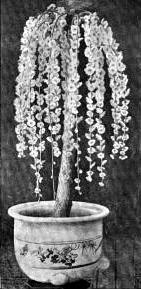| The Garden of Japan (1892):
"Later in March. -- Buds, still buds; and, except for the evergreens, not a leaf to be
seen: but of buds an ample supply of Mume, Pyrus, and Magnolia. At a ball given in commemoration of the
Constitution, with the exception of a few early Camellias,
the decorations consisted entirely of branches of Pine and boughs of buds, all arranged with the most consummate taste. One of
the hanging baskets was made of split bamboo, of a truncated 8-shape not unfamiliar to us in the West; within the basket an upright
glass vessel full of water in which gold fish disported themselves, and inside this again a dark green joint of Bamboo holding
branches of Camellia -- a thing of joy to be remembered. A few days later arrive pots with dwarf trees simply smothered with
bloom -- among them the lovely white Pyrus japonica, almost a stranger, I think, in England. A few days later still the
Camellia season is full upon us. Of course we know all about Camellias at home; I have even seen moderate-sized trees growing
out of doors in England; but in Japan C. japonica [14] 
GARDENERS GOING TO A FLOWER FAIR WITH DWARF TREES.
grows in the most reckless profusion, and in protected spots to an extraordinary height; it
is indeed the queen of flowering shrubs... [15]
A DWARF TREE OF PRUNUS MUME.
[16] "... I have the wish, but not the power, to devote some space to the delightful little
flower-trees which are so characteristic a feature of Japanese gardening science. I have, however, been quite unable to get
any reliable information as to how the wealth of flowers is produced, beyond the fact, which will probably suggest itself to
gardening minds, that the root-growth is retarded by tight straw bandages. The accompanying illustration of a dwarf
plum-tree will give some idea of the great beauty of these little trees. The trunks are often thirty, forty, or more years
old, but they are covered with a cascade of blossom, the young flowering branches being arranged with a profound art. The
science of this arrangement is traditional, and, I believe, unwritten. It is based, of course, on the predominant idea of
all the flower arrangements, which is -- beauty of line. The trimming of the buds is so arranged that you seem to see every
flower on the tree at once -- no one standing in another's light..." [34] "...The white Wistaria (W. brachybotrys) has larger flowers but much shorter racemes than the lilac, and is not of such free habit. Arbours are, however, often covered with it. Used as a dwarf tree for the house it is exceedingly handsome." 2 |